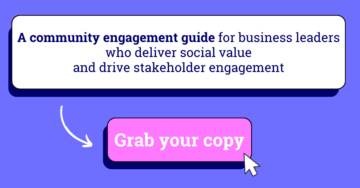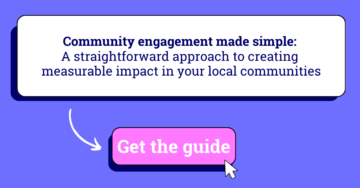Businesses are going all in on their community engagement strategies. But what is community engagement really?
It all depends on what you mean by the word “community.” When some businesses (particularly marketers) talk about community, they’re referring to people who support their brand. In other words, their customers, followers, and fans.
When we talk about community, we’re talking about the people who live and work in the local areas where your business operates. We define “community engagement” as the active participation of businesses, local community groups, residents, and stakeholders to achieve sustainable outcomes and allow communities to thrive.
This form of community engagement is also referred to as stakeholder engagement, civic engagement, and community collaboration, among other nomenclature. But don’t let all the buzzwords confuse you.
It all comes down to working with your local communities to improve people’s lives.
Unfortunately, all the community engagement models, frameworks, and methodologies can get overwhelming and keep many businesses from making community engagement part of their plans.
Busy business leaders need a straightforward way to make an impact in their communities without having to learn loads about this complex subject. This Simple Guide to Community Engagement Planning is a good place to start.

Reasons to develop a community engagement strategy
Many businesses have long supported their local communities, whether through actions like food bank collections, sponsored events, or Christmas-giving campaigns. But these days, many companies are moving away from these traditional standalone actions towards more thoughtful community engagement strategies that ultimately create more value.
Community engagement has become a top three priority for ESG and CSR leaders. Procurement and marketing teams are following suit. Their motivations vary from role to role, but this increased focus comes down to three big factors.
Communities need support now more than ever.
Consumers are pressuring businesses to step up and help.
New regulatory requirements require businesses to provide Social Value as part of projects if they want to earn public sector contracts.
Rising community challenges
Our 2023 State of Social Impact Report revealed that community challenges have reached an all-time high. Between the pandemic and the cost of living crisis, the last four years have had brutal consequences.
Low-income populations in the UK are struggling. The non-profit organisations that support them are running out of resources. There simply isn’t enough public funding available to keep community service programs going.
Many businesses understand this crucial need and are stepping up to fill the gaps. 91% of business leaders say they believe their company has a responsibility to act on ESG issues.
Growing pressure from consumers
And it’s not just that businesses see supporting local communities as the right thing to do. There’s a lot of external pressure at play.
- 83.2% of UK consumers want brands to represent a cause, especially when it comes to poverty and inequality.
- 80% of consumers want businesses to solve society’s problems.
- 76% percent of consumers say they will stop doing business with companies that treat employees, communities, and the environment poorly.
Companies that want to stay relevant simply can’t afford to ignore consumer demands.
Tightening requirements around Social Value
Then there are the new Social Value requirements.
Social Value is a way of measuring the economic, social, and environmental impact that businesses have on communities. The UK government first introduced the Social Value Act in 2012. In the 12 years since, the conversation has evolved from a mere suggestion to consider how businesses benefit local communities to a full-on requirement mandating that commercial buyers within the government take Social Value into account during their procurement processes.
Now businesses trying to win public sector contracts must prove how they help their communities. The private sector is starting to adopt these requirements as well. Procurement teams across the country report a 500% increase in social value questions when bidding for new projects.
Business benefits of a community engagement strategy
As businesses scale up their community engagement strategies, they’re seeing loads of positive business results.
Community engagement is an effective way to increase win rates on bids, drive customer and employee satisfaction, and boost key brand metrics like awareness and value.
Whatever the motivations for getting started with community engagement, the bottom line is that creating an impact in local communities works.
- Companies committed to people and the planet grow 28x faster than the national average.
- Brands that have a high positive impact on people’s lives have 2.5x more value than their competitors.
- Corporations with active social responsibility strategies have generated 20% more revenue and £1.28 billion more shareholder value.
Getting started with community engagement
If you’re looking for a simple way to make community engagement part of your plans, check out our guide to community engagement planning. It’s a practical tool that:
- Delivers a straightforward way to make an impact in your communities
- Shares four practices to shape your community engagement plan
- Includes case studies from other brands taking community action
- Introduces a tool that makes community engagement simple
If you’re ready to reap the rewards of community engagement but haven’t been sure where to begin, get your free copy here.
